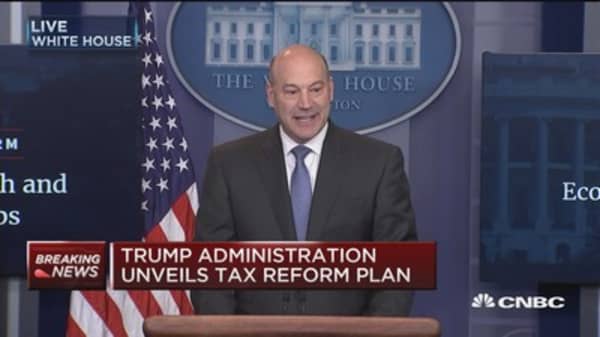Add to that fact, that there have been precious few examples of tax cuts remaining revenue neutral. In almost all cases, budget deficits surged in the aftermath of large- scale reductions in corporate and individual rates.
Let's take the 1981 Reagan tax cuts, for example. Taxes were cut dramatically, from the confiscatory levels of prior periods, to much more reasonable levels that helped bring the U.S. out of a serious "double-dip" recession in the early 1980s.
Like President Trump's team, the Reagan team argued that the tax cuts would pay for themselves with faster economic growth … something then-Budget Director David Stockman referred to as the "rosy scenario."
The Reagan team, of which he was a part, simply plugged growth numbers into the budget that would show how the tax cuts would bring in enough revenue to pay for themselves, something Treasury Secretary Steve Mnuchin reiterated in announcing the details of Trump's tax plan on Wednesday.
It is a dubious argument, at best, since there are no empirical studies that show, in isolation, unfunded tax cuts raise revenue for the Treasury, even with faster growth.
The supply-siders, with all due respect, also often fail to recognize the myriad other factors that led to the "roaring 80s."
They never point out that the Federal Reserve engaged in equally massive monetary stimulus, beginning in 1981, bringing interest rates down from record highs.
For those who conveniently can't — or don't — remember, the Fed, under inflation-fighter Paul Volcker, had pushed short-term interest rates up to a staggering 20% by 1980 to bring an end to double-digit inflation.
But when the recession threatened to turn to depression, the Fed aggressively slashed interest rates, driving the federal-funds rate, the rate banks charge each other on overnight loans, from 20 percent to below 6 percent by the autumn of 1986.
That monetary stimulus, coupled with supply-side tax cuts, caused the economy to boom, even as budget deficits ballooned.
In addition to tax and rate cuts, government spending exploded in a Keynesian frenzy in the early 1980s, as the Reagan administration and Congress boosted spending on both defense and social programs, simultaneously.
The Reagan administration also aggressively devalued the dollar in the autumn of 1985, another item that accelerated economic growth that had nothing to do with tax reform.
In other words, every economic stimulant known to man was used to goose the economy in the 1980s, and despite extremely strong growth, there remains no evidence that the tax cuts were revenue neutral in any way, shape, or form.
With the exception of the late 1990s and early in 2000, we've had deficits ever since.
The only tax cut that appeared to pay for itself was the reduction in capital gains taxes under President Clinton.
The decade-long stock market bubble, from October of 1990 to January of 2000, produced huge capital gains for investors who cashed in on the action. Once they cashed out, they paid a windfall to the government, leading to brief budget surpluses that dissipated all too quickly.
I should note, however, that President Clinton also benefited from the so-called "Peace Dividend" that the end of the Cold War brought to his government.
Reduced tensions with the fallen Soviet Union allowed the Clinton administration to reduce defense spending, which, in turn, narrowed the budget gap significantly.
President George W. Bush fared no better than Ronald Reagan with his tax cuts, however necessary they might have been in the wake of the stock market crash in 2000, the subsequent tech depression, and the aftershocks from the terror attacks on 9/11.
Once again, the unfunded tax cuts added to the deficit by an estimated $2 trillion, while the wars in Afghanistan and Iraq, added even more.
So, while a massive tax cut would be welcome to those who would benefit from it (and it's still mainly the top 5 percent of all wage earners), let's call tax reform what it is … an unfunded liability that boosts growth but busts the budget.
Commentary by Ron Insana, a CNBC and MSNBC contributor and the author of four books on Wall Street. Follow him on Twitter @rinsana.
For more insight from CNBC contributors, follow @CNBCopinion on Twitter.




